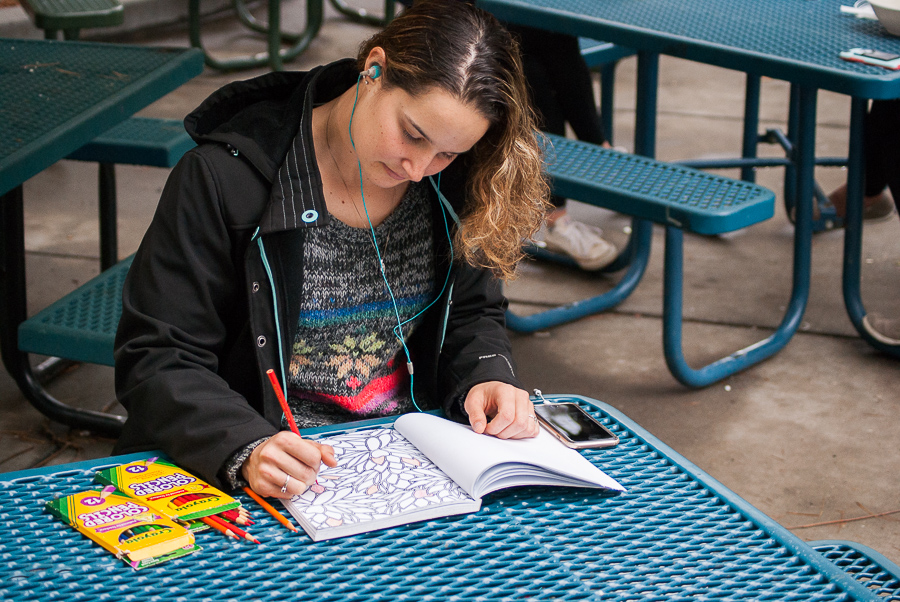
How students benefit from practicing art
It is no mystery that college students lead stressful lives. Balancing work, friendships, internships, sports, etc. on top of college-level curriculum often takes a toll on sleep schedules and sense of peace. For many students, watching the new season of “Stranger Things” serves as a good escape from worries brought on by busy schedules and challenging classes. In this way, Netflix can provide a brief refuge from the difficulties of college life, but there are also other platforms of art that can help students relieve stress.
The diversity of art mediums and forms available to help destress is immediately clear. For Julie Lobrutto, a third-year animal biology major, and Michelle Gin, a fourth-year wildlife fish and conservation biology major, their preferred mediums are very accessible. Gin recently started typography and hand lettering. Although Gin had already discovered oil paints, this was something new to Lobrutto.
“I mostly draw using pens or colored pencils, but last quarter I took an oil paints class which introduced me to a whole new world of mediums,” Lobrutto said.
Fayanne Kirkpatrick, a third-year neurobiology, physiology and behavior major, utilizes graphite alongside watercolor and acrylics.
“I draw people and add elements of surrealism,” Kirkpatrick said.
Layla Al Asadi, a second-year psychology major, similarly draws with ink and colored pencil, but also plays the piano and paints with acrylics and watercolor.
“Over the past couple years, I developed a unique relationship with the piano,” Al Asadi said. “Although I did not enroll in any classes, I think a big part as to why I consider the piano a form of art is due to my experience as a self-taught pianist. I started practicing Turkish melodies, and ever since the piano has been a resort for peace and relaxation and an instrument I will always treasure.”
Al Asadi is not alone in being self-taught, as Kirkpatrick also falls under that category.
“I was self-taught, so [I’ve been playing] ever since I could hold a pencil,” Kirkpatrick said.
While Lobrutto’s mother was more of a pushing agent by signing her up for classes in the summers so she wouldn’t be bored, Al Asadi’s mother was more of an inspiring source for her interest in art.
“My mom was an artist […] she used to have sketchbooks in her drawers, and I always found her art intriguing,” Al Asadi said. “When I was young I also had multiple of sketchbooks, and I used them to creatively communicate with myself. I think having a relationship with oneself allows one to know themselves better and thus the world around them.”
When you first start out, it takes time to go from stick figures to more developed art. Kirkpatrick admits she has evolved with age.
“The people I draw look more like people now than they did when I used crayons to draw in kindergarten,” Kirkpatrick said.
Even if stick figures turn out to be your maximum level of achievement in art, just remember that every form of expression is a valid one in its own right, as Lobrutto mentioned, and that it is no reason to give up.
“People think that because their drawings look like stick figures, they don’t have a creative bone in their body, but that is not true,” Lobrutto said. “I try and encourage my friends to doodle and not criticize themselves because art is just another way of expression.”
There might even be something else you would be more adept at, as Gin proposed.
“Art can be incredibly calming because it allows you to focus on something that you can control, which can be especially valuable in a student’s stressful life,” Gin said. “I am a firm believer that everyone has some form of artistic talent (whether it’s drawing, singing, sculpting, etc.) and that there is no wrong way to create art. Finding something you think you’re good at and not comparing yourself to others can be an incredibly rewarding and self-fulfilling process.”
If all this isn’t enough to motivate you to relieve your stress through the arts, Al Asadi mentions a Ken Burns quote that may just change your mind: “Insist that we support science and the arts, especially the arts. They have nothing to do with the actual defense of our country — they just make our country worth defending.”
What makes art calming for each of these students?
Lobrutto: “I love how art can transcend though differences and resonate within everyone because it can be interpreted in so many directions. It has the ability to heal, tell a story and educate, which I believe is extremely powerful.”
Gin: “This may sound a bit cheesy, but I love that when I create art I forget the rest of the world. I can focus only on the lines and strokes I am creating and know that I am in control. Any standards or expectations are my own, and so I don’t have to worry about creating things that other people like; I can instead focus on what makes me happy.”
Kirkpatrick: “There is something about drawing that separates me from my current problems. Whenever I am under a lot of stress, all I want to do is paint or draw and get away from it all. The act of creating makes me feel accomplished.”
Al Asadi: “Art allows me to transform my intangible emotions into tangible emotions- knowing so calms me down. I turn to art to reflect on the world around me, and it also helps me answer my own questions about the universe. It sometimes pleases me, and at other times it frustrates me, but this is the beauty of art — it transcends emotion.”
Written by: Cecilia Morales — arts@theaggie.org



